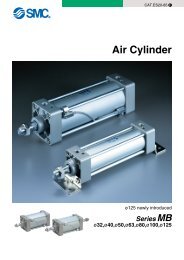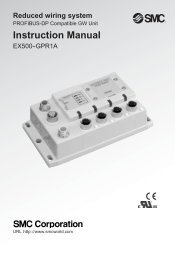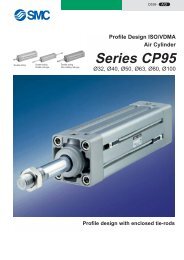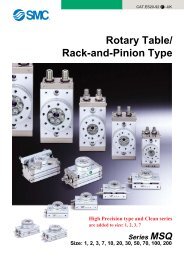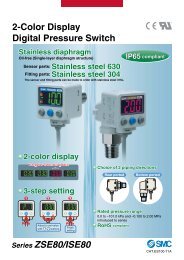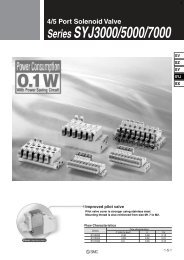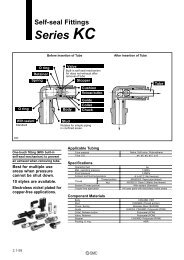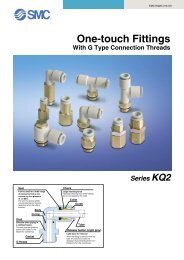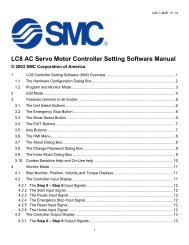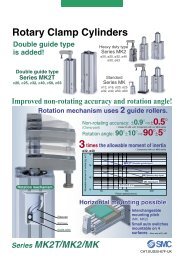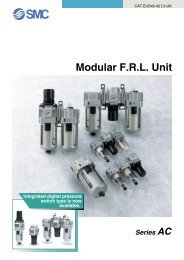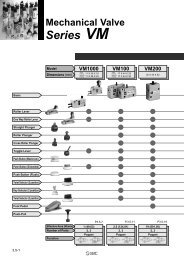Installation and Maintenance Manual Series VT307/317/325 ... - SMC
Installation and Maintenance Manual Series VT307/317/325 ... - SMC
Installation and Maintenance Manual Series VT307/317/325 ... - SMC
- No tags were found...
You also want an ePaper? Increase the reach of your titles
YUMPU automatically turns print PDFs into web optimized ePapers that Google loves.
CoilCoilCoilCoilCoilCoilTube connection (push-in fittings)1. Ensure that the end of the tube is cut square.2. Push the tube firmly into the fitting until it stops.3. Pull back on the tube to ensure that it is securely gripped.4. To disconnect the tube push down on the collet <strong>and</strong> holddown. Withdraw the tube from the fitting <strong>and</strong> release colletwhen the tube is removed. Collet Guide Collar Tube retainer TubeElectrical connection (DIN <strong>and</strong> terminal <strong>VT307</strong>)DIN terminal with lamp <strong>and</strong> surge protection have built in wiringconnections. Connect as per Fig 4.Fig 4Electrical connection (VT<strong>317</strong>)VT<strong>317</strong> series has 90° incremental positioning. Change electrical entryposition as follows. Loosen nut , remove coil from the bodyassembly , put positioning pin into required place, replace coil <strong>and</strong> secure nut .Fig 5Ground Tube seal Body O-ring StudTerminal No. 1 2DIN terminal + ––Terminal + ––VT<strong>317</strong>, VT<strong>325</strong> have no polarityDIN terminal with plateApplicable cable dia: ø4.5~ø7Applicable crimping terminal: 0.Y terminal (1.25-3)LubricationThese valves have been lubricated for life at manufacture <strong>and</strong> requireno additional lubrication.CAUTIONHowever, if a lubricant is to be used, a turbine oil type #1 (ISO VG32)should be used. If a lubricant is used, continuous lubrication must becarried out as the original lubricant will be washed away.WARNING<strong>Manual</strong> override operationExercise extreme CAUTION when operating a solenoid manual overrideas connected equipment will commence operation. Ensure allsafety measures are in place.Non-Locking push type (all valves)1. Push down on the manual override button (moulded black rubber)until it stops.2. Hold this position for the duration of the check. (ON position).3. Release the button <strong>and</strong> the override will re-set to the OFFposition.Push-Locking slotted type (VT<strong>325</strong>)To lock1. Insert a small bladed screwdriver into the slot <strong>and</strong> push downuntil it stops.2. Turn the override 90° left or right depending upon which optionis required (normally open or normally closed) until it stops.3. Remove the screwdriver.WARNINGIn this position the manual override is in the locked 'ON' position.To unlock1. Insert a small bladed screwdriver into the slot of the manual override.2. Turn the screwdriver 90° in the reverse direction.3. Remove the screwdriver <strong>and</strong> the manual override will re-set to theOFF position.CAUTIONThe design of the VT series (V type) valves are such that they may beused for vacuum applications.However, <strong>VT307</strong> (V) <strong>and</strong> VT<strong>317</strong> (V) VT<strong>325</strong> (V) must not be used as avacuum holding valve.If any valve is used in a dusty environment a filter should be insertedin the exhaust port <strong>and</strong> if a suction pad is used the filter should beinstalled between the pad <strong>and</strong> the valve.CAUTIONLeakage voltage (Fig 6)Please note, if a C-R element is used for contact protection, pleaseallow for an increase of leakage voltage which may pass through theC-R element.Contact points*Fig 6C-R elementValveLeakage voltageLeakage currentPowersupply* Please take note that non-contact relays sometimes have built-incurrent protection.The percentage of leakage voltage that remains on the coil after deenergizationshould be kept under 15% (<strong>VT307</strong>) or 20% (VT<strong>317</strong>) or15% (VT<strong>325</strong>) in the case of an AC coil, <strong>and</strong> under 3% (<strong>VT307</strong>) or 2%(VT <strong>317</strong>) or 2% (VT<strong>325</strong>) in the case of a DC coil, of the rated voltage.Surge voltage suppressionLamp/Surge voltage protection circuitAC48VDC or lessFig 7ACDCFig 8ACDCFig 9Terminal No. 1 (+)Fittings tightening torqueTerminal No. 2 (-)Terminal No. 1 (+)In case ofassemblyTerminal No. 2 (-)ZNR With surge voltage protection circuitZNRLEDIn case of assemblyIn case of lamp assemblyLEDZNRThread Tightening torque N-m (kgf/cm)1/8 7-9 (70-90)1/4 12-14 (120-140)3/8 22-24 (220-240)Using DIN connector with the series <strong>VT307</strong> (Fig 10)Disassembly1) Loosen screw <strong>and</strong> pull housing directly upward to removeconnector from the device (such as solenoid).2) Remove screw from housing <strong>and</strong> retain.3) Notch indicated by an arrow is at the bottom of terminal block. Insert screwdriver in the clearance between housing <strong>and</strong>terminal block , <strong>and</strong> pry housing off to remove terminalblock . Refer to Fig 10.4) Remove cable ground , <strong>and</strong> take out washer <strong>and</strong> rubberpacking .Wiring1) Pass cable ground , washer <strong>and</strong> rubber packing throughcable <strong>and</strong> insert into housing .2) Peel off a correct length of the coating of cable as shown inFig 10 <strong>and</strong> connect the cable end with crimp-style terminal .3) Remove screw (or loosen Y-shaped terminal) from terminalblock , mount crimp-style terminal to terminal block <strong>and</strong>tighten screw securely.Note: Tighten screw with torque range of 5 kgf/cm+/-15%.Remarksa) Wiring can be carried out with bare cables. If so, loosen screw(with washer) , insert lead wires in bracket <strong>and</strong> tighten thescrew.b) maximum outer diameter of cable should range from ø4.5mmto ø7.0mm.c) Applicable crimp-style terminals are shown in the table.Assembly1) Pass parts through cable as follows: cable ground , washer, rubber packing <strong>and</strong> housing . Connect cable to terminalblock . Then press terminal block into housing untilit clicks in place.2) Insert parts into the cable inlet of housing as follows: rubberpacking <strong>and</strong> washer , <strong>and</strong> tighten cable ground securely.3) Place gasket between the bottom part of terminal block <strong>and</strong> plug or device. Insert <strong>and</strong> tighten screw over the housing.Note: Tighten screw with torque range of 5 kgf/cm+/-20%.Remark: Connector orientation can be changed through an angle of180 degrees depending on the assembly of housing <strong>and</strong> terminalblock .Using DIN connector with series VT<strong>317</strong>, VT<strong>325</strong> (Fig 11)Disassembly1) Loosen screw <strong>and</strong> pull housing directly upward to removeconnector from the device (such as solenoid).2) Remove screw <strong>and</strong> remove gasket a or b.3) Notch (a) indicated by an arrow at the bottom of terminal block. Insert screwdriver into the clearance at the bottom, <strong>and</strong> lifthousing off to remove terminal block . Refer to the correctfigure.4) Remove cable ground , remove washer <strong>and</strong> rubber packing.Wiring1) Pass cable ground , washer <strong>and</strong> rubber packing throughcable <strong>and</strong> insert these into housing .2) Peel the coating of cable to the dimension shown in the figurebelow <strong>and</strong> connect the cable end with crimp-style terminal .3) Remove screw with washer e (or loosen Y-shaped terminal)from terminal block , mount crimp-style terminal to terminalblock <strong>and</strong> tighten screw e securely.Note: Tighten screw with torque range of 5 kgf/cm+/-15%.Remarks:a) Wiring can be carried out with bare cables. If so, loosen screwwith washer e, put lead wires in bracket d <strong>and</strong> tighten thescrew again.b) Maximum size of crimp-style terminal should be as follows:O-shaped terminal: 3.5 for lead wire of 1.25mm 2 sectional areaY-shaped terminal: 4 for lead wire of 1.25mm 2 sectional areac) Cables with outer diameters ranging from ø6mm to ø12mmcan be used.Note: For outer diameters between ø9mm <strong>and</strong> ø12mm, remove innerpart of rubber packing before use.Assembly1) Press terminal block into housing until it clicks in place.2) Place parts into the cable inlet of housing as follows: rubberpacking , washer <strong>and</strong> cable ground <strong>and</strong> tighten securely.3) Place gasket a or b between the bottom part of terminalblock <strong>and</strong> the plug on device. Insert <strong>and</strong> tighten screw overthe housing .Note: Tighten screw with torque range of 5 kgf/cm+/-20%.WARNING<strong>Maintenance</strong>UNDER NO CIRCUMSTANCES ATTEMPT TO CHANGE THESOLENOID AS THIS IS AN INTEGRAL PART OF THE VALVE ANDDOING SO WILL NEGATE ANY SUCH <strong>SMC</strong> WARRANTY.When you enquire about the product, please contact the following<strong>SMC</strong> Corporation:ENGLAND Phone 01908-563888 TURKEY Phone 212-2211512ITALY Phone 02-92711 GERMANY Phone 6103-402-0HOLLAND Phone 020-5318888 FRANCE Phone 01-64-76-10-00SWITZERLAND Phone 052-34-0022 SWEDEN Phone 08-603 07 00SPAIN Phone 945-184100 AUSTRIA Phone 02262-62-280Phone 902-255255 IRELAND Phone 01-4501822GREECE Phone 01-3426076 DENMARK Phone 8738-0800FINLAND Phone 09-68 10 21 NORWAY Phone 67-12 90 20BELGIUM Phone 03-3551464 POLAND Phone 48-22-6131847<strong>VT307</strong>Fig 10VT<strong>317</strong>/<strong>325</strong>Fig 11baSelf-tightening screwEnlarged view



